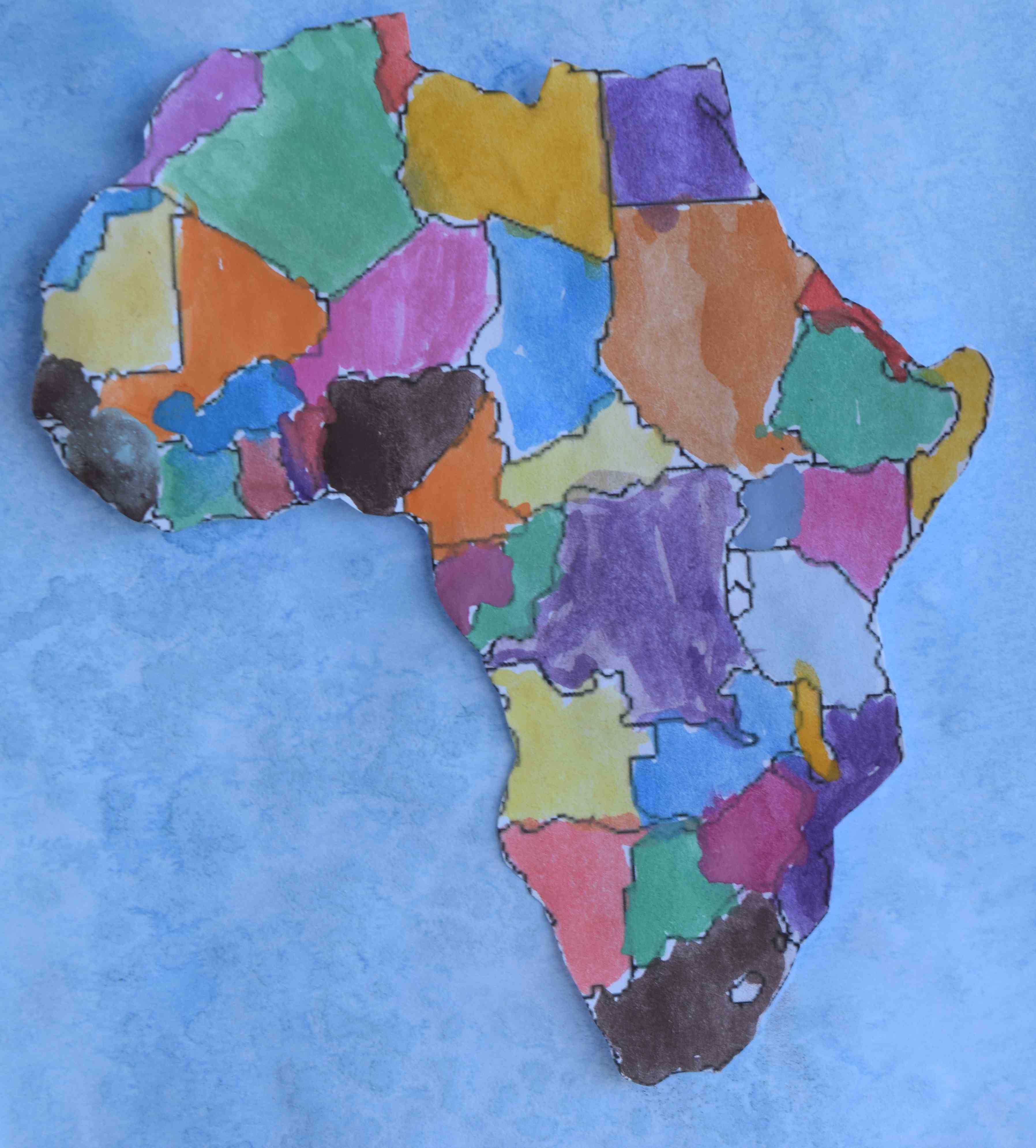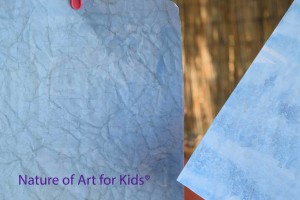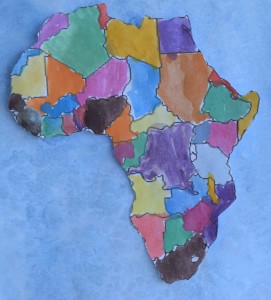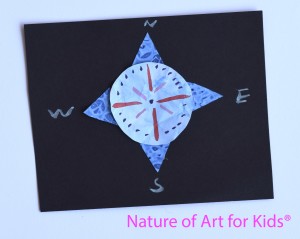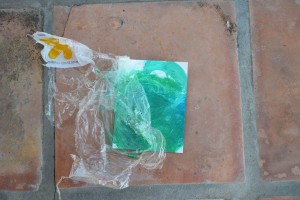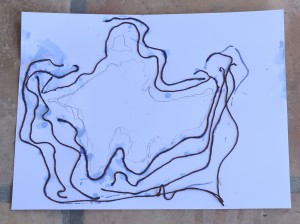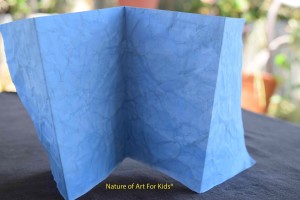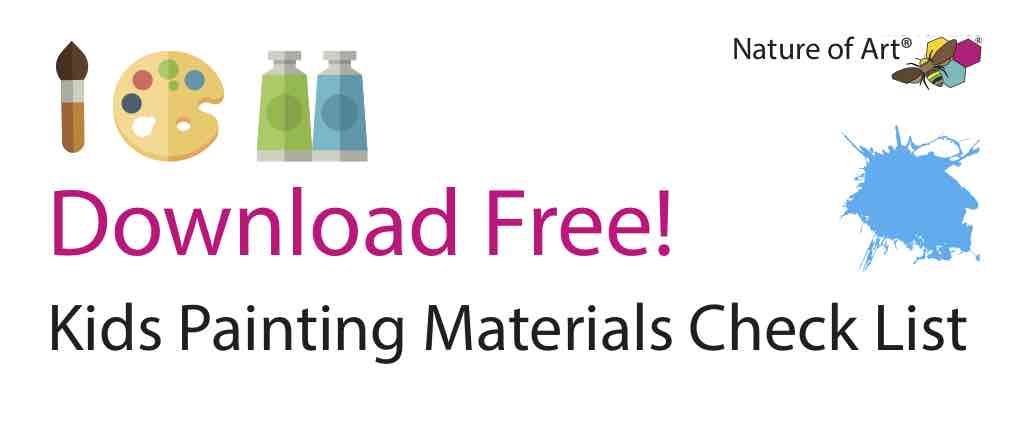Making water marks
Here are eight different ocean water art techniques you can teach kids. These textures can make water maps interesting textures. These textures can also create ocean water marks around landforms. These painting lessons are great for all ages. Elementary children can do most steps independently.
Rather than painting water basic blue, use interesting ocean textures. You can turn learning about maps into fun engaging art. Yon can integrate geography with art making. Kids can also use these techniques in other types of art projects.
When children enjoy the process of creating textured papers, the lesson becomes interesting. Learning geography will become more meaningful because of the art they handmade. Children learn in layers and can connect information through the process of expressing. This makes creating more purposeful. Once children create textured papers, they will become more selective. They will be more deliberate with their map planning ideas.
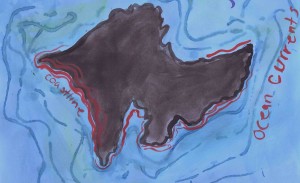
Ocean water facts
Here’s a few fun facts you and your students can learn together:
- Why is the ocean blue?
- Why do some parts of the ocean look darker?
- What is a coastline?
- What causes waves in the ocean?
- How much water covers our planet?
- Why is the largest body of water salty?
Learning about water and map ideas
- What is a globe?
- What is a map?
- What are the four orientations to the four directions?
- What is a compass rose?
- What is a map Legend?
Different ways to use textured water papers
Collect and save scraps for future map making projects. Save every scrap! Collage papers into a compass rose, or bookmarks. Take kids near water to see the features of water. If you don’t live by a large body of water, check out videos. The Discovery website is great. Look at books and encyclopedias for pictures.
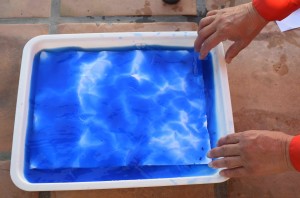
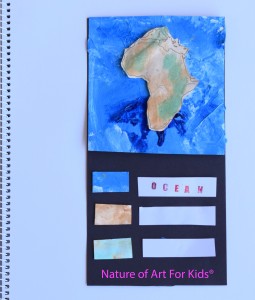
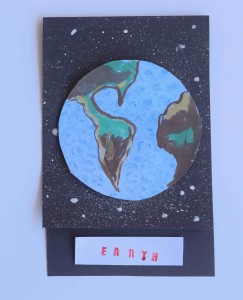
Materials to make textures
Paper Surface
Watercolor paper (Standard (9 x 12 pad)
Plain white copy paper 8 1/2 x 11, or 11 x 17
Thicker white printer copy paper 11 x 17 (some thing heavy that does not rip easy when wet, maybe 100 lb book weight)
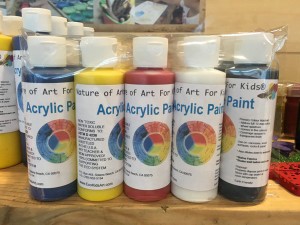
Types of paints to use:
Paintbrushes
- Large (we used our kids three size set of paintbrushes)
- Medium
- Small
- Sponges
Technique Supplies:
- Yarn or String (any color)
- White Basic Wax Crayon
- Spray Bottle
- Color Wheel (you can find one online and print out to show kids)
8 OCEAN WATER – TEXTURE TECHNIQUES
1. SALT ON WET WASH
Sprinkle salt on top of a wet wash paint, the salt will start to gather the watercolor pigments. This effect will be different with different grains of salt. With a spray bottle, gently spray water over salt. You will see the texture change and move around. Its fun! Leave to dry completely, then brush off the salt from paper. You might have to scrub hard to get every grain off.
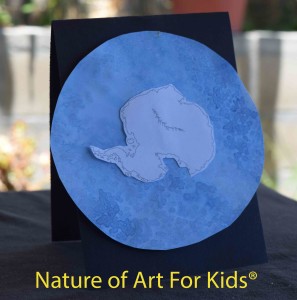
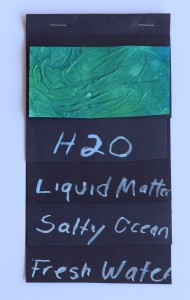
2. PLASTIC BAG TEXTURE
Crinkle plastic or wax paper over wet paint, let paint completely dry. Then remove plastic from paper. You should see interesting marks left from plastic.
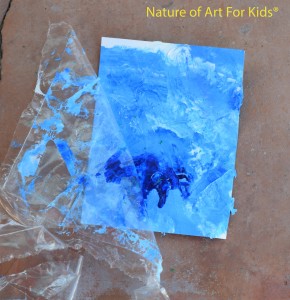
This was created with acrylic blue and white paint. I just put it down really rough without blending too much. I then placed plastic on top and smudged around until all paint covered the surface of the paper. This came out beautiful.
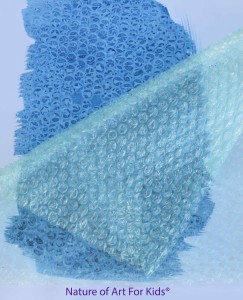
3. BUBBLE WRAP TEXTURE
This texture was so much fun to do and easy. I was looking around for plastic and found bubble wrap instead!
Paint the paper with a wet wash of blue paint, then lay the bubble wrap on top. Press firmly, then leave flat to dry for a few hours. Pull off and wow, you will see the texture of the bubble wrap left on paper. If it helps place a book on top while trying.
If you look at these four small black booklets below. I created the ocean, river, lake and pond. You can see how great this creates a nice texture and use of scraps.
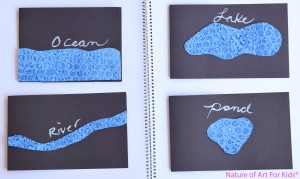
I have to say this is my favorite. Soaking yarn with blue paint and letting dry. When it’s all dry you can see what will happen, after you remove all the yarn. I used the our blue water acrylic watered down. You should be able to see interesting line marks.
4. YARN TEXTURE
This was a blast to do! Get any yarn or string, does not matter thickness or color. Put dark blue watered paint into a bowl. Cut lots of long and short strings from yarn. Submerge the strings in blue paint to soak up color. Then creatively place strings in places you image water current around your landform. Leave to dry flat for a few hours, then pull off strings. After you pull them off you can paint a wash of color over the marks.
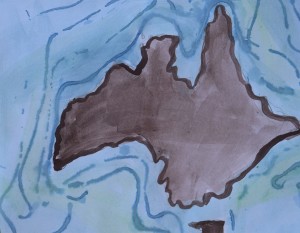
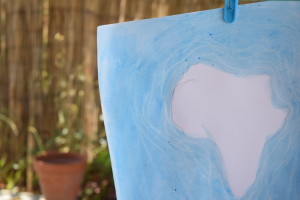
5. CRAYON WAX RESIST
This ones tricky for kids at first time. You want to have kids draw out the content or land form first, then take a white crayon and draw water current rings around the landform. What’s tricky is you can’t see the white marks your making. Show kids first on a different paper what wax resist does so they understand the technique and effect you’re trying to create.
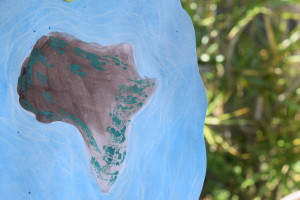
6. PAINTING WITH A SPONGE ON DRY PAPER
If you look closely at the Africa content painting, I went in and painted brown first and let dry. Then I did a technique called dry watercolor painting over it. So the green would not blend into the brown. If you look closely you see the brown blend with the green and they blend as a wash. So this is called dry watercolor painting, using less water on by paintbrush.
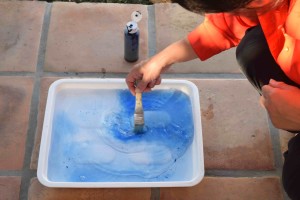

7. VINTAGE MAP LOOK
Get a large blank paper and crumble up slowly and carefully into a ball. Slowly unwrap trying not to tear the paper. Once you have it all unfolded, smooth flat. Dip paper into blue paint prepared before hand. I used our acrylic brilliant blue paint by dripping a few drops in the water. I like to use acrylic better than watercolor because I can make the mixture darker. The darker paint gets into the creases. You will see the paint in the cracks of the paper giving the paper an old vintage look. If you have an iron handy, you can later iron paper smooth for kids to write on.
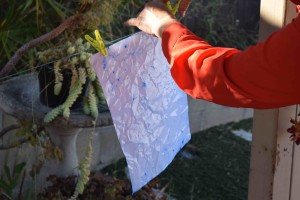
8. DRY BRUSHSTROKE
Here are some bookmarks we made with our scraps. With the dry scraps of the salt textured paper, I taught some of my students how to make brushstrokes over dry paper. Similar to the sponge painting on top. If you look closely the new small water brushstrokes are clean and don’t blend. We used some of the dry watercolor cake paints with very little water to make nice clean dry brushstrokes.
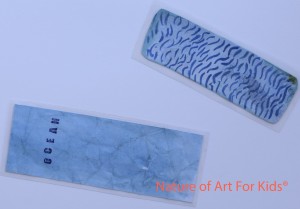
I hope you try these. Love to hear how it worked for you!
Art Teacher – Spramani Elaun
A Short Cut Just for You
If you’d like to learn more about all getting kids painting, read my book, Kids Painting.
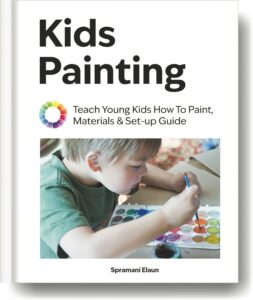
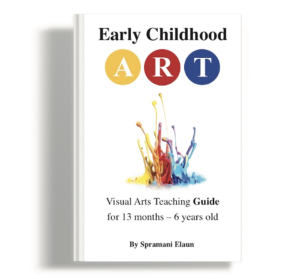
All rights reserved © 2025, Nature of Art®

No part of this blog may be used or be reproduced in any manner whatsoever including reproducing, publishing, performing, and making any adaptions of the work – including translation into another foreign language without written permission except in the case of brief quotations embodied in critical articles and reviews. Nature of Art® Publishing P.O. Box 443 Solana Beach, California 92075.
